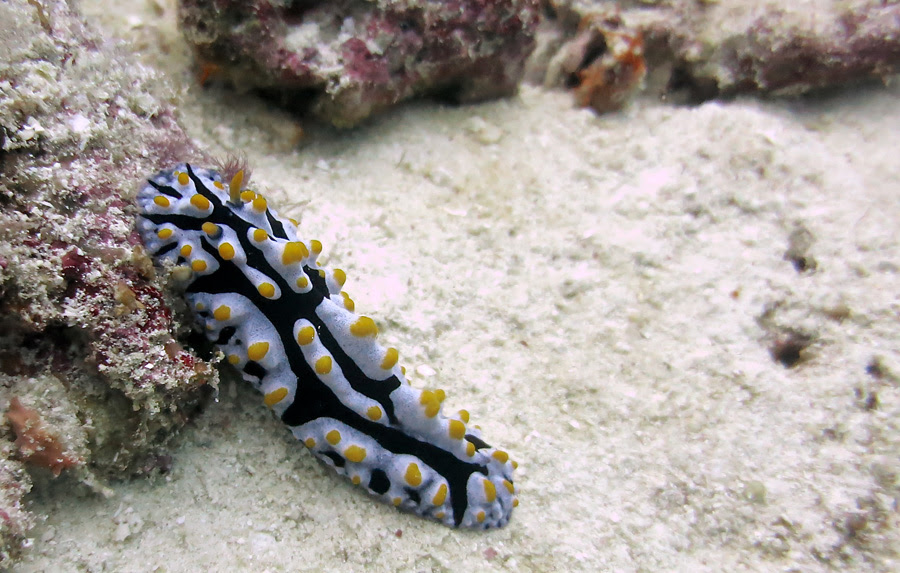Raja Ampat has a huge variety of Nudibranch sea slug species, learn more about a few of them...
NUDIBRANCH SPOTTING
Sea slugs belong in the Phylum Mollusca within the Class of Gastropoda, further divided into the subclass Opisthobranchia. This subclass includes several orders of sea slug which are often all mistakenly lumped into the category Nudibranchia- Nudibranchs but also include; Cephalaspida- Headshield slugs, Sacoglossa- Sapsucking slugs, Anaspidea- Seahares, and Notaspidea- Sidegill slugs. Sea slugs are found through out the worlds marine environments and are particularly prevalent in Raja Ampat where divers with a keen eye are able to marvel that theses amazing creatures.
All sea slugs have a pair of sensory tentacles on their head, and many have a secondary pair called rhinophores, used to help sea slugs to “smell” their way around detecting different chemicals molecules in the water. Sea slugs have gills to help them breath under water and while these structures are particularly obvious in some species aiding in their identification, others gills are hidden within folds of their bodies. Some species of Sapsucking slugs have not developed gill structures at all and instead exchange gasses through appendages on their body know as cerata.
As a group Sea slugs have an incredibly varied diet with some species browsing on algae, others on sponge and corals, and a few others on jelly fish or even other less fortunate Sea slugs! Scientists have also observed that some Sea slugs are able to carry out photosynthesis in a similar way to corals by growing and storing an algae called zooxanthellae within their bodies, utilizing the energy they produce from light in times when food is scares!
Phyllidia Varicosa - Swollen Phyllidia
Kingdom: Animalia Phylum: Mollusca Class: Gastropoda Sub-class: Opisthobranchia Order: Nudibranchia Suborder: Doridina Family: Phyllidiidae Genus: Phyllidia Species: Phyllidia varicose
Phyllidia varicose eat sponges but have no hard mouth-parts. Because of this they soften their prey by secreting digestive enzymes on to the surface and suck up the resulting “casserole” of now soft tissue. Members of this family gill structure extends from the side of their bodies protected by a “skirt” of tissue so divers usually cant see them.
Chromodoris coi - Co's Chromodoris
Kingdom: Animalia Phylum: Mollusca Class: Gastropoda Sub-class: Opisthobranchia Order: Nudibranchia Suborder: Doridina Family: Chromodorididae Genus: Goniobranchus Species: Chromodoris coi
On occasion some species of nudibranchs including Chromodoris coi will wave their mantles or skirts up and down in a rhythmic fashion, much like dancing! Investigators are still unclear as to why this behavior is carried out, but think it may have something to do with finding a mate. Ironically most sea slugs have poor vision at best and therefore are unable to marvel at their own beauty or in the case of some species their dancing abilities.

Tambja gabrielae - Gariela's Tambja
Kingdom: Animalia Phylum: Mollusca Class: Gastropoda Sub-class: Opisthobranchia Order: Nudibranchia Suborder: Doridina Family: Polyceridae Genus: Tambja Species: Tambja Gabrielae
Tambja gabrielae and other nudibranchs in this family feed on bryozoans or marine moss animals as they are more commonly known, sessile colonial animals that are found encrusting on rocks. Members of the genus Tambja are able to swim over short distances in the water column by pushing off from the bottom and awkwardly flexing their body from side to side. Although this may not be an energy effective form of swimming, it goes allow for a quick get away should the need arise!



